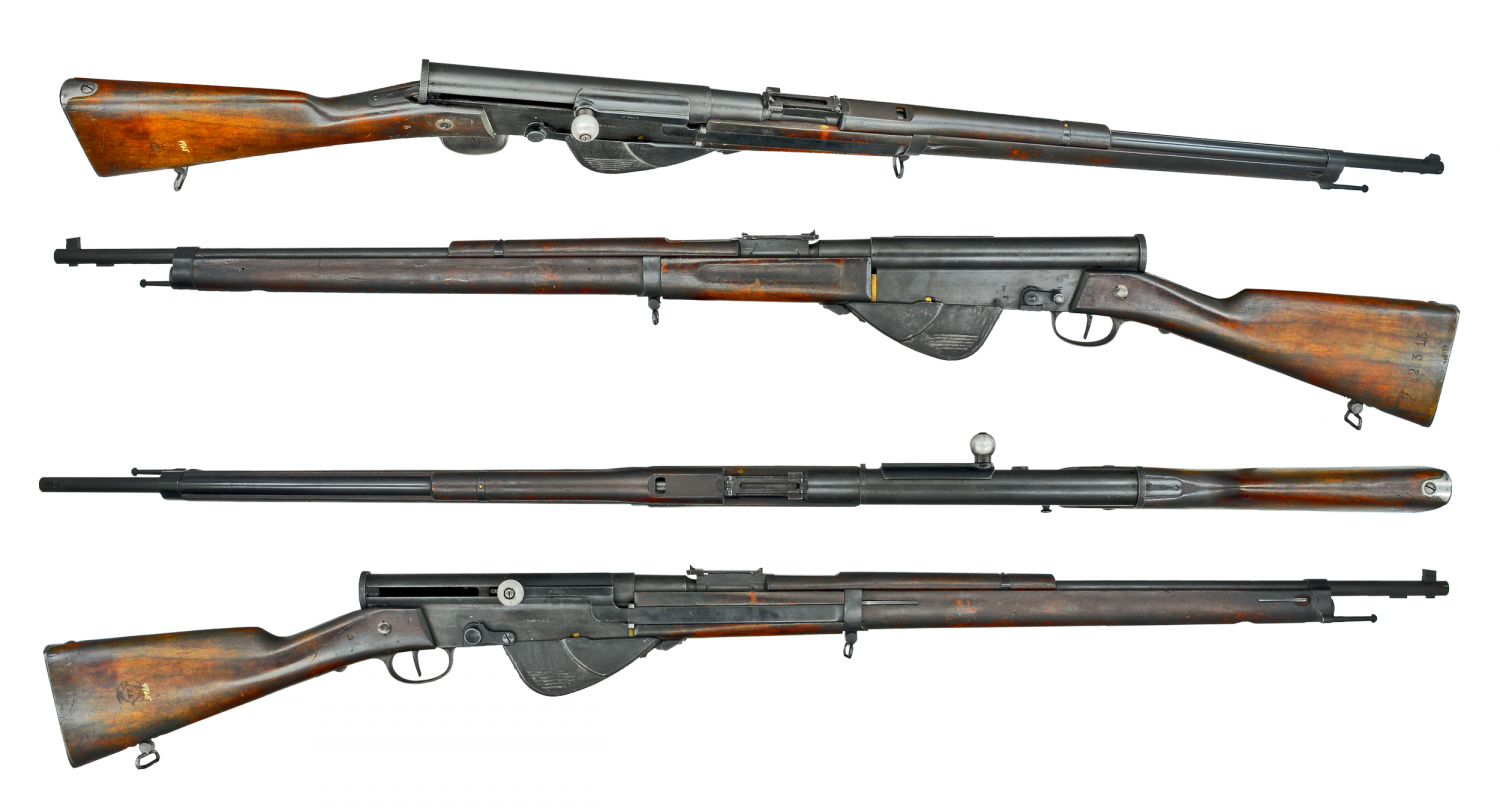Beginning in the last decade of the 19th Century, the French government began work on the next great advancement in infantry small arms technology: The selfloading rifle. By 1916, after the outbreak of World War I, they had produced what many consider the most advanced rifle of its time: The Meunier A6 Carbine.
This story begins in 1894, when a French weapons inspector at Puteaux named Etienne Meunier began work on an automatic rifle functioning via the then-new principle of gas operation. Meunier’s first rifle was finished in 1897, and presented in 1898 as the STA No 4, though it later would be designated the Meunier A1. It functioned via direct impingement operation, and used a rotating bolt with five interrupted thread type lugs, and held 8 rounds of experimental 6x58mm ammunition. For the time, this was an incredibly advanced firearm, firing a 103gr bullet at a muzzle velocity of 2,953 ft/s semiautomatically, with an unloaded weight of just 8.4 lbs.
As French ammunition experiments continued, Meunier produced two more designs which unfortunately were lost during the liberation of France in World War II, the A2 (STA No 5) and A3 (STA No 6), both of which were in 8mm caliber. Following that, Meunier produced his first carbine, the A4 (Carbine STA No 1), which was chambered for the same 6x58mm round as the A1, but with a smaller 5-round magazine, a 10-inch shorter overall length, and – oddly – a grip safety behind the trigger guard. The carbine was intended for cavalry units, and a small number were manufactured for troop trials with six regiments in 1903. Despite the fact that the results of these trials were overwhelmingly favorable, and the rifle was recommended for adoption, development was abandoned.
Meunier’s next weapon, the A5 (STA No 7) of 1908, relocated the gas tube to the right side of the gun and added a Swiss-style “barrel keg” charging handle. It was chambered for a new 6x61mm caliber, which produced an incredible 3,300 ft/s muzzle velocity with its 104gr spitzer bullet. The A5 held six of these small caliber, high velocity cartridges.
In 1909, the French Supreme War Council formally announced the program for a new selfloading infantry, basing their requirements on a 1905 specification created by the Small Arms Commission. These specifications included a caliber no less than 6.5mm, accuracy and penetration equal to the Lebel to 1,000 m, ability to fire the rifle as both semiautomatic and repeater, and – importantly – length permitting firing from two ranks. This last seriously outdated requirement ensured that the next rifle would be no shorter than the Lebel it replaced.
Meunier responded to these requirements with a completely new design, the A6 (previously STA No 8), which used the short-recoil principle* instead of direct impingement gas operation, coupled with a bolt using interrupted-thread lugs, similar to Meunier’s previous designs. The A6 was also chambered for a new 7mm round, a caliber that would be modified several times, producing a confusing number of variations.
*Huon routinely describes the Meunier rifles as using “long-barrel recoil”, but the actual description of the Meunier’s operation in his book is consistent with what we know as “short-recoil”, not “long-recoil”.
EDIT: I am wrong (but so is Huon, it seems)! After publishing this article, I was contacted by the Springfield Armory National Historic Site, who have in their possession several Meunier rifles, and they informed me that the barrels on those rifles are capable of full rearward travel, whereupon the bolt unlocks. For posterity, here is the description given in Proud Promise of the Meunier’s action:
When fired, the barrel recoils, carrying with it the bolt assembly. Through the helical cam groove in the bolt carrier, the bolt head is rotated and unlocked. The barrel stops its rearward travel, allowing the bolt assembly to continue rearward, extracting and ejecting the empty case. The barrel returns to its place while the bolt assembly compresses the hammer spring and cocks the hammer. It then goes forward, introducing a new cartridge into the chamber. After the last round, the bolt catch retains the bolt assembly in the rear position.
It seems I am also wrong about the rifle having detachable magazines; instead, it has magazine extensions, like a Mauser, Springfield, or FN-49. Therefore, the 5, 10, and 15 rounder magazines could not be removed and swapped, but only reloaded via stripper clips at the charger bridge.
The Meunier design again performed so well that it was actually adopted in 1910, though the French ordnance officials were still debating whether to begin production by 1913. Eventually, they decided not to, and the entire French autoloading program was cancelled due to concerns of impending war.
The story doesn’t end there, though. As some may have noticed, the A6 Meunier Carbine hasn’t even entered the picture yet. When war did indeed break out in 1914, the prescience of the French decision was evident, but by mid-1916, it was evident that a selfloading rifle was desperately needed for the war effort. The French were already tooling up to make another selfloading rifle, the RSC 1917, but it was happening more slowly than they could afford. Meanwhile, the Meunier A6 had passed state trials and had already been produced in small numbers, so a small batch of A6s were produced in 1916 as the 7mm Fusil Automatique Modéle 1916, and was produced by the Manufacture Nationale d’Armes de Tulle, with some help from the arsenal at Châtellerault. Interestingly, all Meunier rifles were issued with a cloth action cover, to protect the rifles from mud and debris.
Finally, we get to the Meunier A6 Carbine. Etienne Meunier recognized the need for a shorter rifle than his A6, which had been designed around the obsolete 1909 specification, and developed three new rifles, a cavalry carbine, an infantry carbine, and an aircraft carbine without bayonet lug or handguards. The A6 infantry carbine in particularly was probably the most advanced weapon of its time, as it clocked in at 1,096 mm in length (slightly less than the later M1 Garand), featured a detachable 5, 10, or 15 round magazine (fed by stripper clips, as all Meunier designs were), and night sights. The Meunier A6 Carbine was an effective handy rifle that did very well in trials until the end of the war, but was never mass-produced. Othais of C&Rsenal photographed one of these extremely rare carbines on his recent trip to the Springfield Armory National Historic Site, and has graciously shared these images with TFB:

The awesome Meunier A6 Carbine, one of the very few in the world. Image source: Othais of candrsenal.com, many thanks to him for sharing it.
We mentioned previously that the Meunier rifles beginning with the A6 were chambered for several similar but distinct 7mm rounds, but the final variation that eventually saw production was the 7×56.95mm (often shortened to 7x57mm, although that risks confusion with the 7x57mm Mauser), which used a 50 degree shoulder and fired a 139 gr (9 g) bullet at a muzzle velocity of 2,789 ft/s (850 m/s), which was excellent performance for the period. The 7mm Meunier calibers, collectively, represent the French arm of “infantry magnum” caliber development I mentioned in another post. All 7×56.95mm Meunier rounds were manufactured at Puteaux for the war effort.

An animation of the rear sight on the Meunier A6 Carbine; note the three-dot night sights. Image source: Othais of candrsenal.com
Production of the Meunier long rifle ceased on August 13 of 1917, with 1,013 rifles made. Out of that total, just 843 rifles made it to the front lines, making the Meunier a technically significant footnote in the history of selfloaders in combat. The Meunier was generally well-received, although soldiers constantly complained about its length (hence the Carbine), its unique ammunition, and – like almost all weapons in World War I – its susceptibility to the mud of the trenches. The M1916 Meunier was superseded by the fantastically successful RSC 1917, which was chambered for the standard 8mm Lebel cartridge. That rifle proved to be the first great success story in selfloading rifle history, with over 85,000 units built.

The RSC Mle. 1917, arguably the first truly successful selfloading rifle ever. Adopted by France, used in World War I in combat, and produced in the high tens of thousands. Image source: candrsenal
Meunier filed a patent on his design in October of 1915, but the patent was kept secret until 1920. It is available on Espacenet, here.
The information in this post was mostly collected from Jean Huon’s excellent book Proud Promise, which I reviewed in an article here. I highly recommend that treatise on France’s selfloading program from the 19th Century through to the 1970s.
 Your Privacy Choices
Your Privacy Choices
